
Hawks with White Heads: Types, Pictures and Facts
Have You Ever Seen A Big Bird Flying Above You With A Bright White Head And Thought “what Kind Of Hawk Is That?” You Are Not Alone Many People Get Confused When They Spot These Birds Because They Look Similar To Eagles Or Other Raptors. It Can Be A Little Frustrating When You Want To Know More But Don’t Have A Clear Answer.
That’s Why Learning About Hawks With White Heads Is So Exciting. These Birds Are Powerful Unique And Easy To Recognize Once You Know Their Features. In This Blog We’ll Share Different Types Of Hawks With White Heads Simple Facts And Tips On How You Can Spot Them In The Wild.
Hawks with White Heads
- Black Faced Hawk
- Ferruginous Hawk
- Gray Goshawk
- Hawaiian Hawk
- Long Legged Buzzard
- Mantled Hawk
- Red Tailed Hawk
- Rough Legged Hawk
- Swainson’s Hawk
- Variable Hawk
- White Hawk
- White Necked Hawk
- White Tailed Hawk
Black Faced Hawk
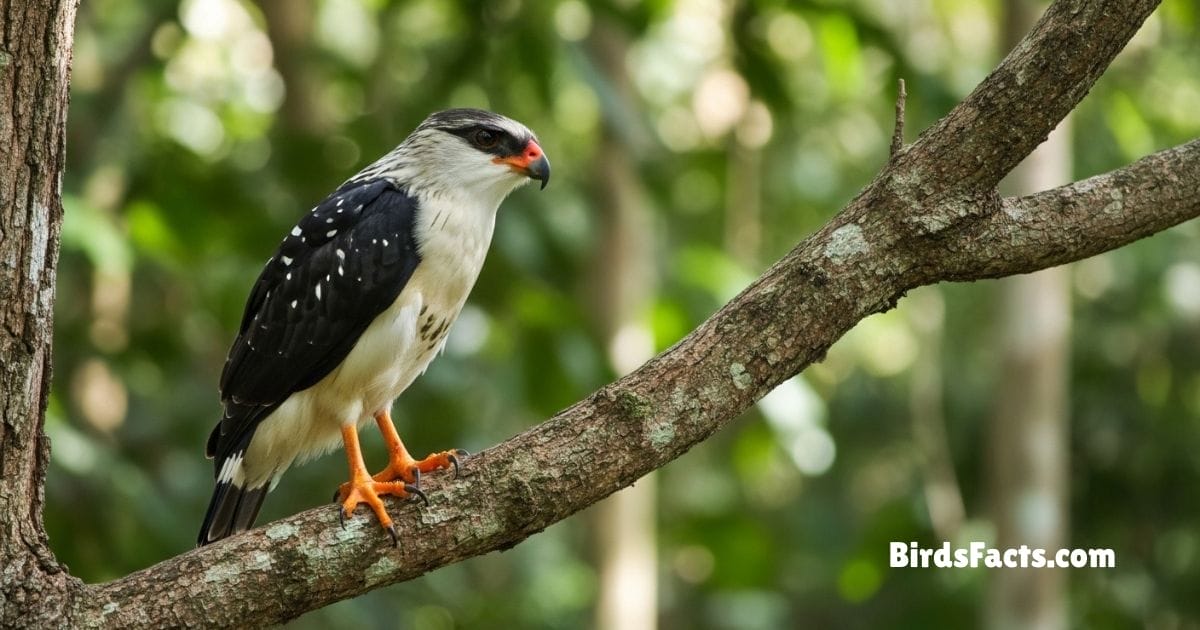
Black Faced Hawk Sitting On A Tree Branch With Striking Black Mask White Breast And Broad Wings
The Black Faced Hawk Is A Rare And Beautiful Raptor Found Mainly In The Amazon Rainforest Of South America. At First Glance It Looks Almost Like A White Hawk But You’ll Quickly Notice The Bold Black Mask Around Its Eyes And Across Its Face. Its Body Is Mostly White With Dark Wings That Contrast Sharply Against The Lighter Plumage. Because Of This Some Birdwatchers Describe It As A “black-and-white Hawk” Which Makes It Easier To Spot In The Dense Greenery Of The Forest.
This Hawk with White Heads Prefers Tall Mature Forests Where It Can Perch Quietly And Scan For Prey. Its Diet Includes Snakes Lizards And Small Mammals And It Hunts With Quick Calculated Swoops. Unlike Open-country Hawks That Soar High In The Sky The Hawk with White Heads Often Stays Within The Canopy Using Cover To Its Advantage. Because It Lives In Such Remote Areas It Isn’t Commonly Seen Which Makes Spotting One An Unforgettable Moment For Bird Enthusiasts. If You Ever Get The Chance To See One In The Wild Its Striking Face Pattern And Graceful Flight Will Leave A Lasting Impression.
| Facts | Detail |
|---|---|
| Range | Found In Northern South America Especially Amazon Basin |
| Key Fact | Recognized By Its Distinct Black Mask Like Face Markings |
| Plumage | White Body Black Face And Black Wing Tips |
| Behavior | Often Perches Quietly In Forest Canopy Watching For Prey |
| Diet | Feeds On Small Mammals Birds And Reptiles |
Ferruginous Hawk
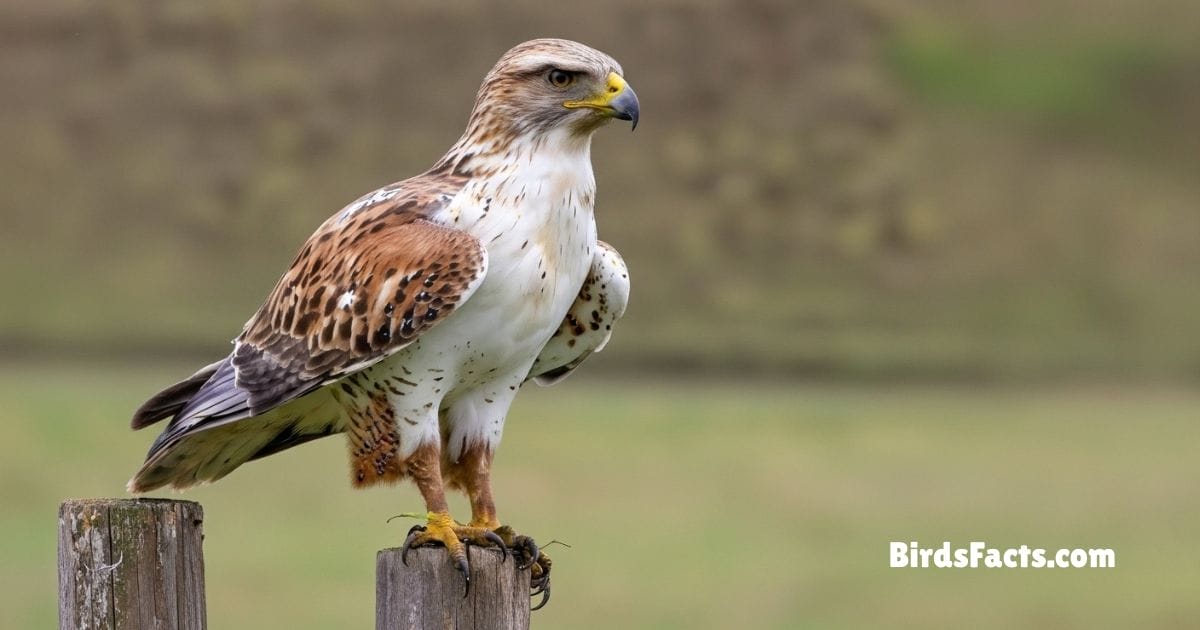
Ferruginous Hawk Perched On Fence Post With Reddish Brown Back Streaked Legs And Wide Powerful Wings
The Ferruginous Hawk Is One Of The Largest Buteo Hawks In North America And Is Often Admired For Its Pale Head And Impressive Wingspan. Its Name Comes From The Rusty Reddish Brown Color On Its Legs And Back But Many Individuals Show A Very Light Almost White Head And Chest. This Pale Form Sometimes Called The “light Morph” Can Make The Bird Look Quite Different From Other Hawks In The Same Region. With Wide Wings And A Robust Body The Ferruginous Hawk Is Built For Soaring Over Open Landscapes.
These Raptors Are Most Commonly Seen In Grasslands Deserts And Prairies. Where They Hunt For Rabbits Prairie Dogs And Other Small Mammals. They Use A Mixture Of Perching And High Circling Flights To Locate Prey Before Swooping Down With Strong Talons. Because They Help Control Rodent Populations Hawks with White Heads Play An Important Role In Maintaining Balance In Their Ecosystem. Farmers In The Great Plains Often Appreciate Their Presence Since These Birds Naturally Reduce Pests. Watching One Glide Across The Sky With Its Pale Head Glowing In The Sunlight Makes Hawks with White Heads Even More Remarkable And Memorable For Any Birdwatcher.
| Facts | Detail |
|---|---|
| Range | Found In North America Especially In Open Grasslands And Prairies |
| Key Fact | Largest Hawk In North America |
| Plumage | Pale Underparts Rusty Red Back And Legs Dark Flight Feathers |
| Behavior | Soars High While Hunting And Nests On Cliffs Or Trees |
| Diet | Feeds On Rabbits Ground Squirrels And Other Small Mammals |
Gray Goshawk
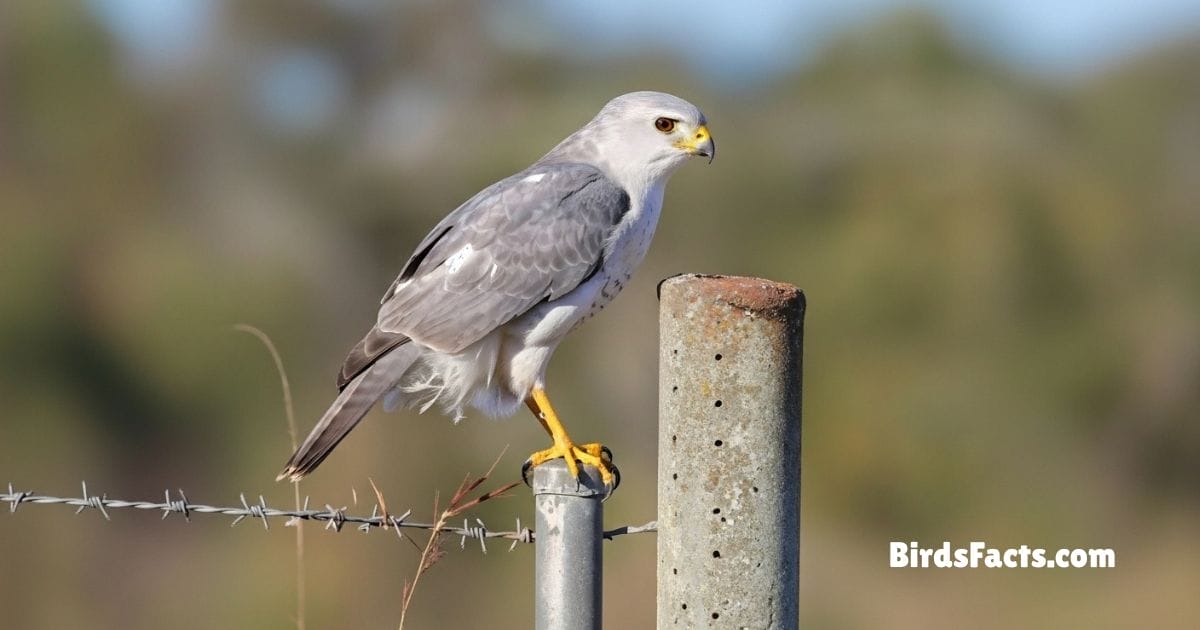
Gray Goshawk Sitting On Tree Branch With Pale Gray Feathers Sharp Eyes And Strong Talons
The Gray Goshawk Is A Striking Bird Of Prey From Australia Known For Having Two Color Forms: A Gray Morph And A Rare Pure White Morph. The White Form Is Especially Stunning As The Entire Bird Appears Snow White Making It One Of The Most Unique Hawks with White Heads. With Long Legs Broad Wings And A Streamlined Body It Is Perfectly Adapted To Fast And Agile Hunting In Dense Forests.
This Hawk Is A Powerful Predator That Feeds On Birds Mammals And Even Reptiles. Unlike Open Country Hawks The Gray Goshawk Relies On Speed And Surprise. It Dashes Through Trees With Incredible Skill Catching Prey Before They Even Realize It’s There. Because Of Its Ghostly White Morph People Sometimes Confuse It With Other White Raptors But Its Size And Hunting Behavior Give It Away. Spotting One Of These Rare White Forms In The Wild Makes Hawks with White Heads Even More Fascinating And Memorable For Birdwatchers.
| Facts | Detail |
|---|---|
| Range | Found In Australia And Surrounding Islands |
| Key Fact | Comes In Two Forms Pure White And Gray |
| Plumage | Either Completely White Or Gray With White Underside |
| Behavior | Agile And Powerful Hunter That Hunts Birds In Flight |
| Diet | Birds Small Mammals And Reptiles |
Hawaiian Hawk
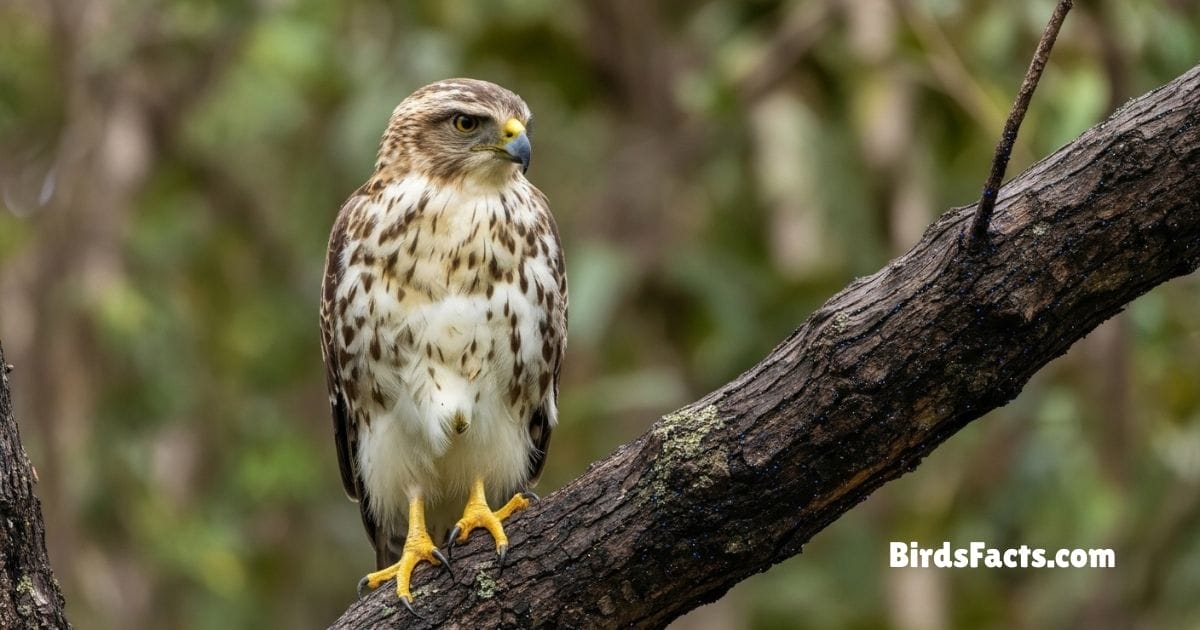
Hawaiian Hawk Perched On Branch With Dark Brown Plumage Sharp Beak And Watchful Eyes
The Hawaiian Hawk Also Called “ʻio” By Locals Is A Unique Bird Of Prey Found Only In Hawaii. It Holds Deep Cultural Importance In Hawaiian Traditions Often Seen As A Symbol Of Royalty And Protection. This Medium-sized Raptor Has Two Color Forms: A Dark Morph And A Light Morph. The Light Morph Shows A Pale Head And Chest Which Makes It Stand Out More Clearly Against The Tropical Forests Where It Lives. Its Piercing Eyes And Strong Build Give It An Impressive Presence Even Though It’s Smaller Than Many Mainland Hawks with White Heads.
Hawaiian Hawks Are Adaptable Hunters. They Feed On Birds Insects And Small Mammals. Sometimes Even Scavenging When Necessary Because They Live Only On The Islands They Face Special Conservation Challenges Especially With Habitat Loss And Introduced Predators. Despite This The Species Has Managed To Survive And Remains A Symbol Of Hawaiian Wildlife. Spotting One Soaring Above The Lush Green Valleys Or Perched In A Tall Tree Is A Breathtaking Moment And Makes Observing Hawks with White Heads In Hawaii Truly Memorable.
| Facts | Detail |
|---|---|
| Range | Endemic To Hawaii Found On Big Island |
| Key Fact | Known Locally As Io And Sacred In Hawaiian Culture |
| Plumage | Dark And Light Morphs Dark Brown Or Pale With Streaking |
| Behavior | Soars Over Forests And Hunts From Perches |
| Diet | Eats Birds Insects And Small Mammals |
Long Legged Buzzard

Long Legged Buzzard Standing On Rocky Ground With Broad Wings Pale Brown Feathers And Keen Eyes
The Long Legged Buzzard Is A Large Raptor Found Across Parts Of Europe Asia And North Africa. True To Its Name This Bird Has Noticeably Long Legs Compared To Other Buzzards Giving It A Tall Upright Stance When Perched. Many Individuals Show A Pale Head And Body With Darker Wings And Tail Feathers. Because Of Its Variable Plumage Some Birds Can Look Almost Entirely White While Others Appear Much Darker. This Makes Identification Tricky But The Pale Head Is Often A Helpful Clue When Spotting Hawks with White Heads.
These Buzzards Prefer Open Landscapes Such As Deserts Steppes And Mountainsides. They Are Excellent Hunters Feeding On Small Mammals Reptiles And Large Insects. When Soaring They Often Hold Their Wings In A Shallow “v” Shape Gliding Smoothly Across Wide Areas In Search Of Food. The Long Legged Buzzard Is Admired For Its Adaptability Surviving In Harsh Dry Habitats Where Few Other Large Raptors Thrive. Seeing One Perched On A Rocky Outcrop With Its Pale Head Catching The Sunlight Makes Observing Hawks with White Heads Truly Memorable.
| Facts | Detail |
|---|---|
| Range | Found In Parts Of Europe Africa And Asia In Open Dry Habitats |
| Key Fact | Known For Its Long Legs Compared To Other Buzzards |
| Plumage | Varies From Pale Cream To Dark Brown With Broad Wings |
| Behavior | Soars In Wide Circles And Hunts Over Open Country |
| Diet | Eats Rodents Reptiles And Birds |
Mantled Hawk
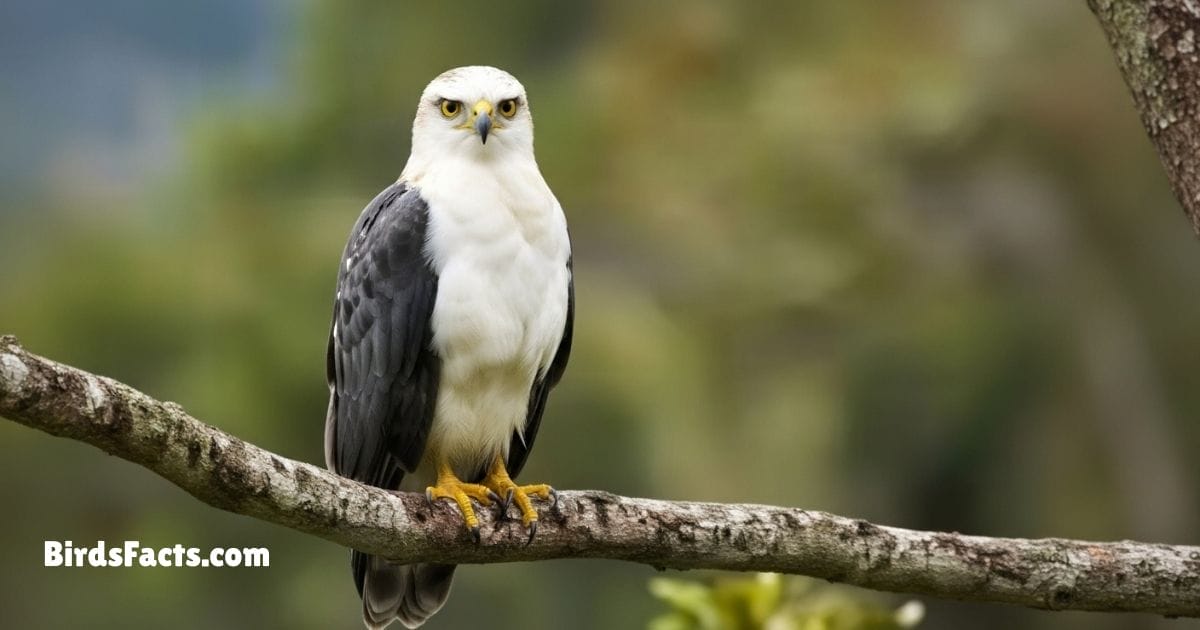
Mantled Hawk Perched On Tree Branch With Dark Gray Mantle White Underparts And Strong Sharp Beak
The Mantled Hawk Is A Rare Raptor Found Mainly In The Tropical Forests Of South America Especially In Brazil And Surrounding Regions. It Has A Striking Look With A Mostly White Head Breast And Underparts Contrasted By Darker Wings And A Back That Appears Like A “mantle” Draped Across Its Body Hence The Name. This Mix Of Pale And Dark Feathers Makes It One Of The Most Visually Distinctive Hawks with White Heads In Its Range. Because It Spends Much Of Its Time In Dense Forests It Is Not Often Seen Adding To Its Reputation As A Mysterious Bird.
This Hawk Hunts Quietly From Perches Within The Forest Swooping Down On Small Mammals Reptiles And Large Insects. Unlike Soaring Species That Patrol The Skies The Mantled Hawk Relies On Stealth And Patience Making It A Master Ambush Hunter. Birdwatchers Who Catch A Glimpse Often Describe It As An Unforgettable Encounter Due To Its Rare Nature And Unusual Coloring. Its Pale Head Is A Key Feature That Helps Identify It From Other Forest Raptors Making It One Of The Most Remarkable Hawks with White Heads For Enthusiasts Exploring Tropical Rainforests.
| Facts | Detail |
|---|---|
| Range | Found In South America Especially In Brazil Colombia And Peru |
| Key Fact | Rare And Elusive Species Often Found In Mountainous Forests |
| Plumage | White Body With Black Mantle Across Back And Wings |
| Behavior | Usually Solitary Perches Quietly While Watching For Prey |
| Diet | Small Mammals Birds And Reptiles |
Red Tailed Hawk
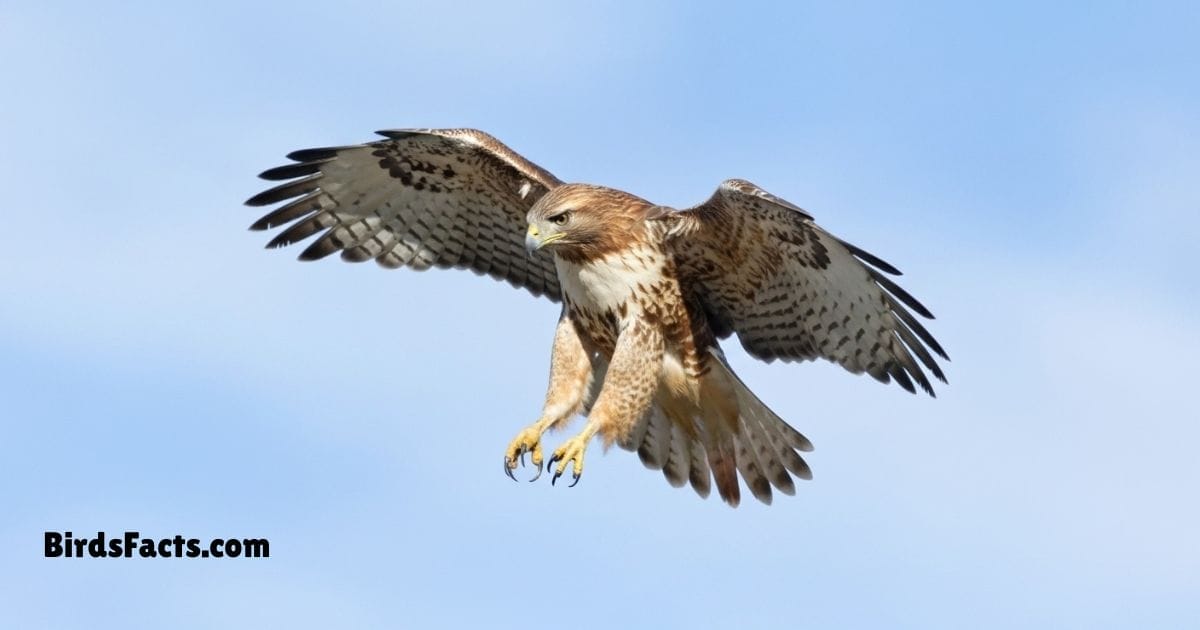
Red Tailed Hawk Perched On Branch Showing Reddish Tail Brown Body And Broad Powerful Wings
The Red-tailed Hawk Is One Of The Most Common And Widespread Raptors In North America But The Krider’s Morph Is A Special Variation That Stands Out With Its Pale Plumage. While Typical Red-tailed Hawks Have A Darker Brown Body And Reddish Tail The Krider’s Form Shows A Very Light Head Whitish Chest And Often Softer Lighter Tones Across The Body. This Pale Morph Is Most Often Seen In The Great Plains Where It Blends Beautifully With Open Skies And Wide Grasslands Making It One Of The More Noticeable Hawks with White Heads In The Region.
Krider’s Hawks Hunt Much Like Other Red-tailed Hawks Feeding On Rabbits Rodents And Birds. They Are Skilled Soarers Circling High Overhead While Scanning For Prey. Their Lighter Appearance Can Sometimes Cause Confusion With Other Pale-headed Raptors Including Ferruginous Hawks But Their Distinctive Red Tail Is Usually The Giveaway. For Birdwatchers Spotting A Krider’s Morph Feels Like Seeing A Rare Version Of A Familiar Species. Its White Head Gleaming In The Sun Makes It One Of The Most Remarkable Hawks with White Heads To Observe In North America.
| Facts | Detail |
|---|---|
| Range | Found Throughout North America In Diverse Habitats |
| Key Fact | One Of The Most Common And Recognizable Hawks In North America |
| Plumage | Brown Upperparts Pale Underside With Distinctive Reddish Tail |
| Behavior | Soars High While Calling With Its Famous Screech |
| Diet | Eats Rodents Rabbits Birds And Reptiles |
Rough Legged Hawk
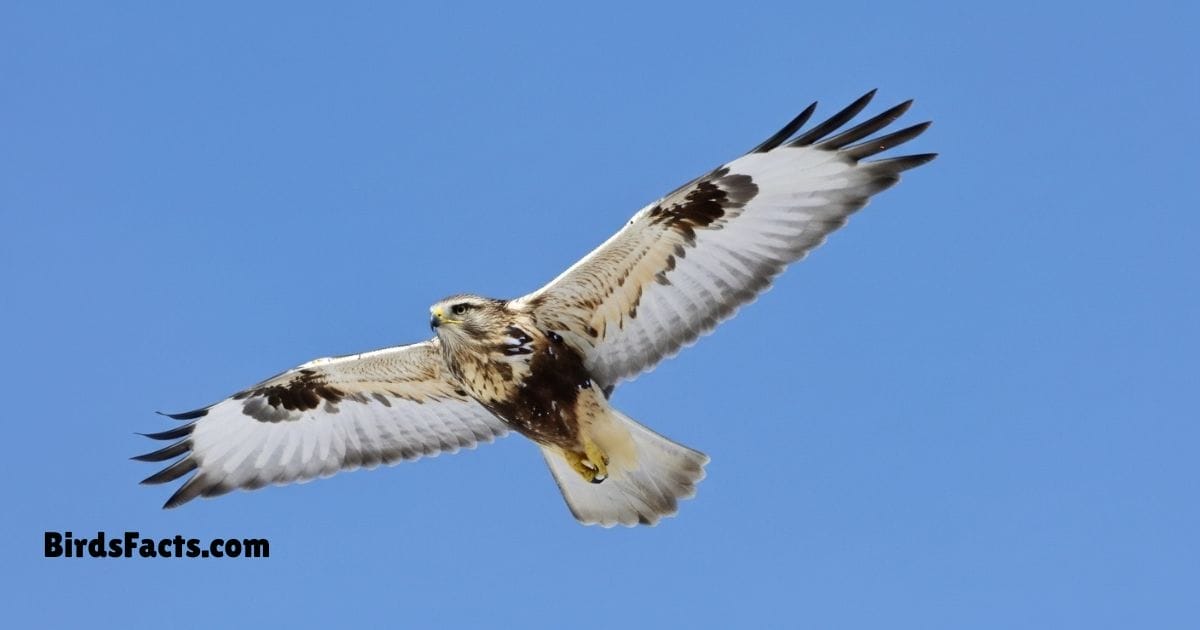
Rough Legged Hawk Perched On Rock Showing Feathered Legs Brown Body And Broad Wings
The Rough Legged Hawk Is A Hardy Raptor That Breeds In The Arctic Tundra And Migrates South During The Winter. It Gets Its Name From The Feathering That Extends All The Way Down Its Legs A Feature That Helps It Stay Warm In Freezing Environments. Many Individuals Have Pale Heads And Light Underparts Contrasting With Darker Wing Patches And A Banded Tail. These Markings Make Them Relatively Easy To Identify Especially When Compared To Other Hawks with White Heads In Open Country Habitats.
Rough Legged Hawks Prefer Wide Treeless Landscapes Such As Tundra Prairies And Open Fields. They Often Hover In The Air Like Kestrels Holding Their Position Against The Wind As They Search For Prey. Their Diet Is Made Up Mostly Of Small Mammals Like Lemmings And Voles Which They Hunt With Great Skill. During Harsh Winters They May Also Take Birds Or Carrion When Necessary. Watching One Hover Gracefully Over A Snow Covered Field With Its Pale Head Catching The Winter Light Makes It One Of The Most Stunning Hawks with White Heads To Observe In Their Winter Range.
| Facts | Detail |
|---|---|
| Range | Found In Arctic Regions Of North America And Eurasia Winters Further South |
| Key Fact | Named For Its Feathered Legs That Keep It Warm In Cold Climates |
| Plumage | Light And Dark Morphs Pale Underwings With Dark Wrist Patches |
| Behavior | Hovers While Hunting Similar To Kestrels |
| Diet | Feeds On Small Mammals Especially Lemmings And Voles |
Swainson’s Hawk
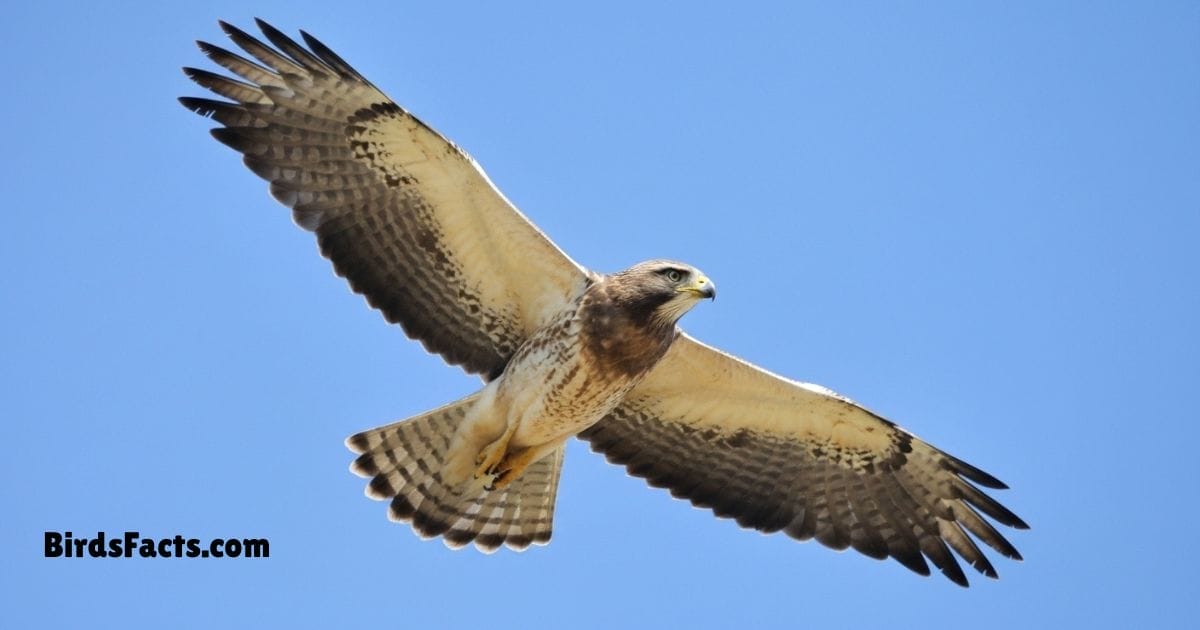
Swainsons Hawk Perched On Branch Showing Light Brown Body Dark Wings And Sharp Beak
Swainson’s Hawk Is A Long Distance Migrant Famous For Traveling Thousands Of Miles Between North And South America Each Year. It Has Several Color Variations But The Light Morph Often Shows A Pale Or Whitish Head Which Stands Out Against Its Darker Wings And Chest Markings. During Migration Huge Flocks Of Swainson’s Hawks Can Be Seen Soaring Together Sometimes In The Thousands Forming A Breathtaking Sight In The Sky. Spotting One Of These Rare Hawks with White Heads Makes Migration Season Especially Exciting For Birdwatchers.
These Hawks Are Opportunistic Feeders. In Summer They Focus On Mammals Like Ground Squirrels But During Migration And In Wintering Grounds They Eat Large Numbers Of Insects Such As Grasshoppers And Crickets. Farmers Often Welcome Their Presence Since They Naturally Reduce Crop Pests. Swainson’s Hawks Prefer Open Grasslands And Agricultural Areas Where They Can Perch On Fence Posts Or Power Poles To Spot Prey. Observing A Pale Headed Swainson’s Hawk Against A Clear Sky Is One Of The Most Memorable Experiences Among Hawks with White Heads.
| Facts | Detail |
|---|---|
| Range | Breeds In North America Migrates To South America For Winter |
| Key Fact | Known For One Of The Longest Migration Journeys Of Any Raptor |
| Plumage | Brown Upperparts Pale Underside And Dark Chest Bib |
| Behavior | Often Seen In Large Migratory Flocks Called Kettles |
| Diet | Eats Rodents Reptiles And Large Numbers Of Insects |
Variable Hawk

Variable Hawk Perched On Tree Branch Showing Brown White Plumage And Broad Powerful Wings
The Variable Hawk Lives Up To Its Name Because It Shows A Wide Range Of Plumage Variations From Very Dark Individuals To Pale Ones With White Heads And Chests. Found Mainly In South America Especially In The Andes Mountains And Surrounding Regions This Hawk Is One Of The Most Adaptable Raptors In Its Range. Some Birds Appear Almost Completely White With Just A Few Dark Markings While Others Are A Mix Of Gray Black And White. The Pale Headed Forms Are Among The Most Striking Hawks with White Heads And Easily Catch The Eye Of Observers.
This Species Often Hunts In Open Grasslands Highland Plains And Mountain Slopes. Its Diet Includes Rodents Birds And Reptiles Making It A Versatile Predator. Unlike Forest Hawks That Rely On Ambush The Variable Hawk Often Soars In Wide Circles Scanning The Ground For Prey. Its Ability To Live In Different Habitats From Valleys To High Elevations Shows Just How Resilient It Is. Birdwatchers Traveling Through South America Often Consider Spotting A Pale Headed Variable Hawk One Of The Most Exciting Experiences Among Hawks with White Heads.
| Facts | Detail |
|---|---|
| Range | Found In South America From Andes To Southern Argentina |
| Key Fact | Shows Great Variation In Plumage Color From White To Dark Gray |
| Plumage | Wide Variety From Pale Whitish To Nearly Black |
| Behavior | Adapts To Many Habitats From Mountains To Grasslands |
| Diet | Small Mammals Birds Reptiles And Insects |
White Hawk

White Hawk Perched On Branch Showing Pure White Body Dark Eyes And Broad Wings
The White Hawk Is One Of The Most Dazzling Raptors Of Central And South America. Almost Entirely White In Appearance This Bird Stands Out Against The Deep Green Backdrop Of Tropical Forests. Some Individuals May Have Dark Wingtips Or Tail Markings But Overall The Pure White Plumage Makes It Unmistakable. Its Bright Appearance Often Leads People To Confuse It With An Eagle But It Is Very Much A True Hawk Species And One Of The Most Stunning Hawks with White Heads To Spot. Birdwatchers Often Consider It A Highlight Because Of Its Snowy Plumage And Graceful Flight.
This Hawk Spends Much Of Its Time Soaring Gracefully Above Forests Or Perching On Tall Trees To Watch For Prey. It Feeds On Small Mammals Reptiles And Large Insects Striking With Quick Precision When The Opportunity Arises. The White Hawk Plays An Important Role In Its Ecosystem Helping To Balance Populations Of Smaller Animals. Spotting This Bird Is A Rare Treat And One Of The Most Beautiful Examples Of Hawks with White Heads Anywhere In The World Making It A Must-See For Bird Enthusiasts.
| Facts | Detail |
|---|---|
| Range | Found In Central And South America From Mexico To Brazil |
| Key Fact | Known For Its Striking Pure White Plumage With Black Wingtips |
| Plumage | Mostly White With Contrasting Black On Wings And Tail |
| Behavior | Soars Gracefully Above Forest Canopies Often Seen In Pairs |
| Diet | Feeds On Small Mammals Birds Reptiles And Large Insects |
White Necked Hawk
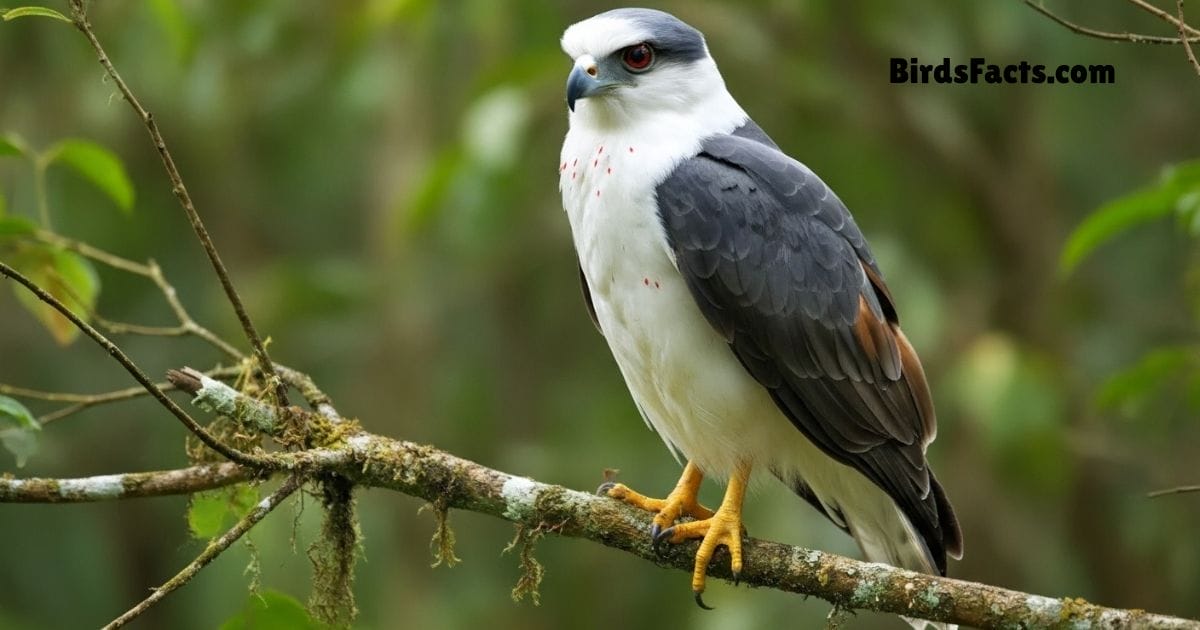
White Necked Hawk Perched On Branch Showing White Neck Dark Body And Strong Wings
The White Necked Hawk Is A Rare Raptor That Lives In The Atlantic Forest Of Brazil One Of The Most Threatened Ecosystems In The World. As Its Name Suggests It Has A Pale Or White Neck And Head Which Contrast Beautifully With Its Darker Wings And Back Making It One Of The Most Stunning Hawks with White Heads In South America. Because It Lives In Dense Forests And Has A Relatively Small Range It Is Not Easy To Spot In The Wild Making Each Sighting A Special Treat For Birdwatchers Who Appreciate Its Elegant Appearance And Silent Hunting Style.
This Hawk Prefers Forested Habitats Where It Can Perch Quietly And Ambush Prey. Its Diet Includes Reptiles Amphibians And Small Mammals And It Occasionally Hunts Other Birds. Unlike Soaring Open Country Raptors The White Necked Hawk Moves Stealthily Through The Trees Using Its Sharp Eyesight And Quick Reflexes. Sadly Its Habitat Faces Ongoing Deforestation And The Species Is Considered Vulnerable. Spotting One Of These Rare Hawks with White Heads In The Green Forest Is A Powerful Reminder Of Nature’s Beauty And Fragility And Makes It A Coveted Experience For Any Bird Enthusiast.
| Facts | Detail |
|---|---|
| Range | Endemic To The Atlantic Forest Of Brazil |
| Key Fact | A Rare Species Threatened By Habitat Loss |
| Plumage | White Head And Neck With Dark Gray Back And Wings |
| Behavior | Secretive Hawk Usually Seen Flying Over Forest Edges |
| Diet | Eats Small Birds Reptiles And Mammals |
White Tailed Hawk

White Tailed Hawk Perched On Branch Showing White Tail Brown Body And Broad Wings
The White Tailed Hawk Is A Powerful Bird Of Prey Found Mainly In South And Central America With Some Populations Reaching Into Southern Texas. Its Pale Head And Chest Make It Stand Out From A Distance While Its Long Broad Wings And Bright White Tail Are Unmistakable In Flight. This Striking Appearance Makes It One Of The Most Notable Hawks with White Heads In Its Range. Some Individuals Also Show Rusty Shoulder Patches Adding Extra Character. Birdwatchers Admire Its Clean White Head And Tail Which Set It Apart From Other Similar Raptors In The Region.
White Tailed Hawks Favor Open Habitats Such As Grasslands Savannas And Coastal Plains. They Hunt Small Mammals Snakes And Large Insects Using Their Keen Eyesight And Powerful Talons. These Raptors Often Soar High Scanning The Ground Below For Prey. Spotting One Of These Impressive Birds With Its Pale Head Bright Against The Sky Is A Highlight For Birdwatchers. Observing Hawks with White Heads Like The White Tailed Hawk In Their Natural Habitat Is A Memorable Experience That Shows The Beauty And Strength Of These Majestic Raptors.
| Facts | Detail |
|---|---|
| Range | Found In Southern United States Mexico Central And South America |
| Key Fact | Easily Recognized By Its White Tail With A Dark Terminal Band |
| Plumage | Dark Gray Back White Underside And White Tail With Black Band |
| Behavior | Prefers Open Country Grasslands And Savannas |
| Diet | Feeds On Rodents Rabbits Snakes And Birds |
Frequently Asked Questions (FAQs)
What Makes Hawks With White Heads Unique?
Their Pale Or White Head Feathers Make Them Stand Out And Easy To Identify Compared To Other Raptors.
Where Can I See Hawks With White Heads?
They Can Be Found In North And South America With Each Species Living In Different Habitats Like Forests Grasslands Or Mountains.
Do All Hawks With White Heads Look The Same?
No Some Are Mostly White While Others Only Have Pale Heads With Darker Wings And Bodies.
Are Hawks With White Heads Endangered?
Some Like The White Necked Hawk Face Threats Due To Habitat Loss While Others Are Still Common And Widespread.
How Do Hawks Help The Environment?
They Control Rodent And Insect Populations Keeping Ecosystems Balanced And Healthy.
Conclusion
Hawks With White Heads Are Among The Most Captivating Birds Of Prey In The World. From The Icy Tundra Where The Rough Legged Hawk Hovers To The Tropical Forests Where The White Hawk And Mantled Hawk Glide Between Trees Each Species Brings Its Own Story And Beauty. Their Pale Heads Make Them Stand Out In The Wild And Highlight Them As Unique Members Of The Raptor Family. Some Are Widespread And Easy To Spot While Others Live In Small Threatened Habitats Remaining Rare Treasures For Birdwatchers Who Get The Chance To Observe Them.
Beyond Their Striking Appearance These Hawks Play An Important Role In Nature. By Hunting Rodents Reptiles And Other Small Animals They Help Keep Ecosystems Balanced. Many Also Hold Cultural Significance Like The Hawaiian Hawk On Its Island Home. Learning About These Raptors Helps Us Appreciate Not Only Their Stunning Pale Heads But Also Their Vital Role In The Environment. Spotting One Soaring High Is A Memorable Experience That Reminds Us Why Hawks With White Heads Are Truly Exceptional Birds Of Prey.








